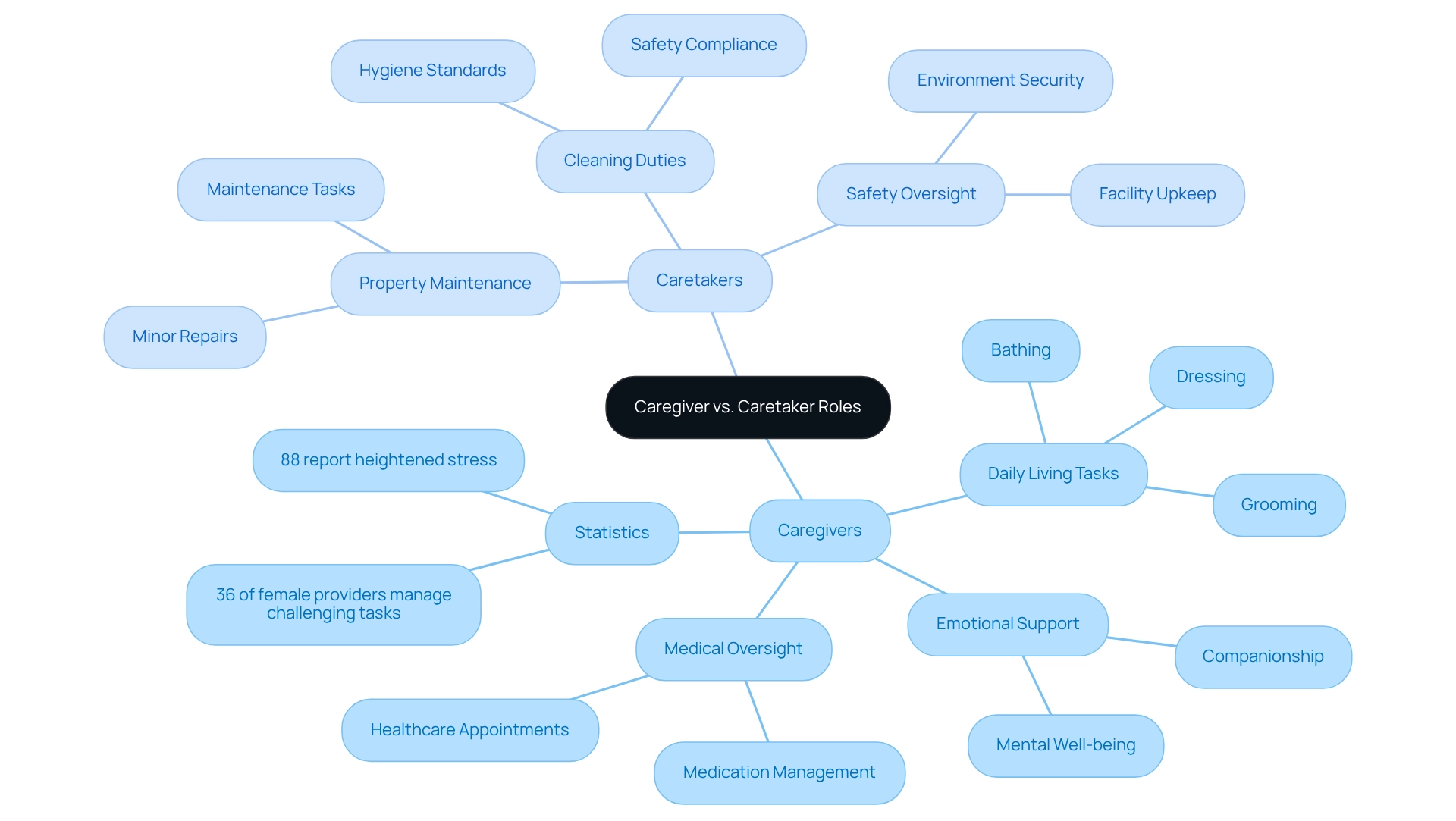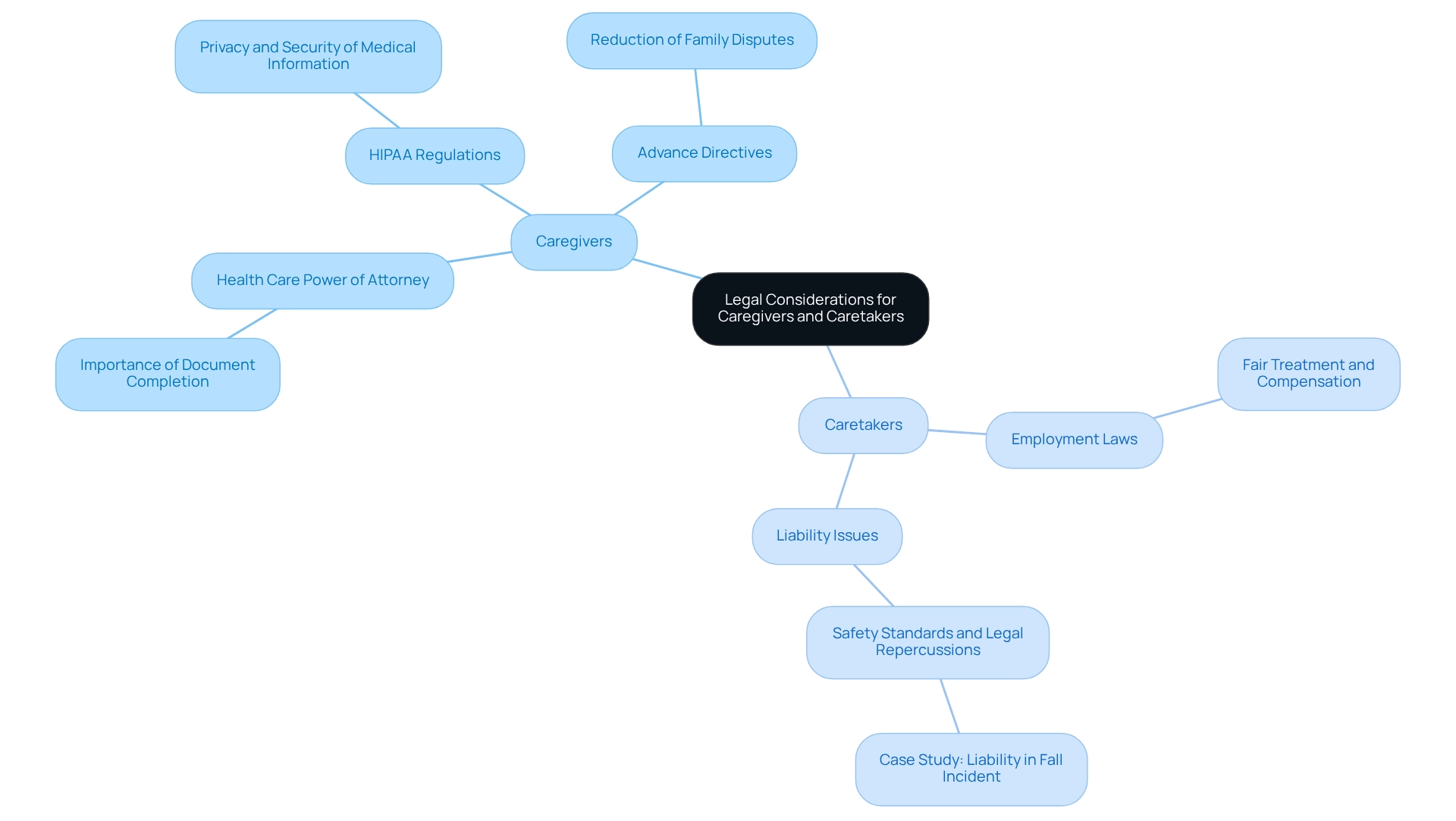Overview
The article clarifies that the primary distinction between a caregiver and a caretaker lies in their roles. Caregivers provide direct personal support to individuals in need, focusing on emotional and physical assistance. In contrast, caretakers are responsible for the maintenance of properties and environments. This differentiation is crucial for families seeking the appropriate type of help. Caregivers enhance the quality of life through personal interaction, while caretakers ensure safe and functional living conditions. Both roles are vital in the caregiving landscape, underscoring the importance of understanding these distinctions as we navigate the journey of care together.
Introduction
In the intricate landscape of caregiving, understanding the distinct roles of caregivers and caretakers is essential for families seeking the right support for their loved ones. Caregivers provide direct, personal care, offering emotional support and assistance with daily activities. In contrast, caretakers focus on maintaining the physical environment, ensuring a safe space for those in need.
As the demand for compassionate care continues to rise, with millions of caregivers in the U.S. alone, the importance of these roles becomes increasingly evident. Families often find themselves navigating complex emotions and decisions during this time. This article delves into the responsibilities, emotional dynamics, and legal considerations that define caregiving, highlighting how both caregivers and caretakers contribute to the well-being of those in need.
By exploring these facets, we aim to empower families to make informed decisions that ensure their loved ones receive the appropriate care and support necessary for a fulfilling life. Remember, you’re not alone in this journey—your comfort is our priority, and we’re here for you.
Define Caregiver and Caretaker
In discussing the difference between caretaker and caregiver, it’s essential to understand that a provider is someone who offers direct, personal support to individuals in need due to age, illness, or disability. This role encompasses emotional assistance, companionship, and help with daily activities such as bathing, dressing, and medication management. Conversely, the distinction between caretaker and caregiver typically refers to someone responsible for the maintenance and oversight of a property or facility, performing duties like cleaning, gardening, or managing household tasks. While support providers prioritize the welfare and individual needs of people, the roles of caretaker and caregiver emphasize that caretakers focus on the physical maintenance of surroundings or items.
As we look toward 2025, there are approximately 53 million support providers in the United States, reflecting the growing need for personal assistance services. This statistic underscores the increasing demand for compassionate aid as more individuals seek help in their daily lives. Home health services, provided by caregivers, are not only more affordable and convenient but also equally effective as treatment received in hospitals or nursing facilities. These services address critical issues such as safety, psychological support, and the overall well-being of seniors, who may face risks like health decline, inadequate nutrition, and social isolation without appropriate assistance.
Recent articles highlight the evolving roles of those who provide care, showcasing their significant impact on the quality of life for seniors and individuals with disabilities. For instance, a case study on assistance provided through the NHTD Waiver Program illustrates how these professionals enhance care for seniors, significantly improving their overall well-being. Caregiver services offer substantial benefits, including customized assistance tailored to individual needs, emotional support to alleviate feelings of isolation, and help with household management, fostering a secure living environment.
Best Care Nurses Registry offers a variety of services, including personalized plans and emotional guidance, ensuring that seniors receive the support they need to maintain their independence and dignity. Understanding the distinction between caretaker and caregiver is vital for families seeking the right type of assistance for their loved ones, ensuring that both personal attention and environmental maintenance are adequately addressed. If you are looking for compassionate and professional caregiver services, we invite you to reach out to Best Care Nurses Registry today. Let’s discuss how we can support you and your family in this journey.

Compare Responsibilities and Duties
Understanding the differences between caretaker and caregiver roles is essential in providing personal assistance and support to individuals. These roles encompass a variety of responsibilities that directly influence the well-being of clients. Caregivers assist with daily living tasks (ADLs) like bathing, grooming, and dressing. They also oversee medications and organize healthcare appointments, ensuring compliance with treatment plans. Furthermore, they provide companionship and emotional support, significantly enhancing the quality of life for those they assist. It’s important to note that 88% of support providers report heightened stress or anxiety due to their responsibilities, highlighting the emotional impact of these duties.
At Best Care Nurses Registry, our Certified Nursing Assistants (CNAs) and Home Health Aides (HHAs) are dedicated to delivering personalized assistance tailored to the unique needs of each individual. They not only help with daily tasks but also maintain regular contact with patients, ensuring that family members and decision-makers are informed about vital health information. This engagement is crucial for enhancing the quality of life and independence of seniors, allowing them to remain in the comfort of their own homes. Our support providers are available for hourly services, with no minimum requirement, making it easier for families to find the right assistance.
In contrast, the differences between caretaker and caregiver roles are clear. Caretakers focus on maintaining the physical environment surrounding individuals. Their responsibilities often include cleaning and maintaining properties to meet safety and hygiene standards. They perform minor repairs and oversee maintenance tasks, ensuring that the environment remains functional. Additionally, they manage schedules for property upkeep, keeping facilities secure and conducive to assistance.
While caregivers provide direct interaction and hands-on help, the distinction between caretaker and caregiver roles emphasizes how caretakers operate more in the background, ensuring that the environment is well-maintained. This distinction is vital, as effective caregiving requires a harmonious balance between personal interaction and environmental management, ultimately contributing to the overall health and comfort of those receiving care. Research indicates that 36% of female providers manage the most challenging caregiving responsibilities (i.e., bathing, toileting, and dressing) compared to 24% for their male counterparts, underscoring the challenges faced by those in caregiving roles.
Addressing the stigma surrounding caregiving in the workplace and promoting work-life balance are essential for improving assistance. As the number of older adults is projected to surpass that of children by 2030, this demographic shift highlights the urgent need for supportive caregiving policies. It is crucial for employers to adapt their practices to meet the evolving needs of caregivers. With the support of Best Care Nurses Registry, families can alleviate stress and ensure the safety and well-being of their loved ones. We’re here for you—call (888) 203-2529 to schedule a consultation and discuss your personalized care needs.

Examine Emotional Support and Relationship Dynamics
Caregivers often form profound personal connections with those they assist, significantly enhancing health and well-being outcomes. This relationship is founded on trust, empathy, and mutual respect, fostering a nurturing environment that promotes independence and empowerment. Caregivers are motivated by a commitment to uplift their clients, providing not only physical support but also emotional reassurance that can alleviate feelings of isolation and anxiety.
At Best Care Nurses Registry, our providers embody this commitment. For instance, Brianna, our administrator in Brevard County, is dedicated to ensuring that all home support needs are met with compassion and kindness. Similarly, Sherie, our most tenured employee, serves as an essential connector between clients and caregivers, prioritizing both the psychological and practical requirements of our clients. Our services encompass individualized support plans, companionship, and assistance with everyday tasks, all designed to foster strong caregiver-client connections that lead to improved health outcomes.
In contrast, the distinction between caretaker and caregiver often reveals that caregivers typically engage in a more transactional relationship, focusing primarily on task completion and property management. While they play a crucial role in ensuring safety and functionality, this approach may limit the emotional engagement necessary for a truly personalized experience. The absence of a deeper connection can result in a less rewarding interaction for those receiving assistance.
Understanding these dynamics is crucial for families when selecting suitable assistance, particularly in grasping the difference between caretaker and caregiver for their loved ones. Research indicates that strong caregiver-client relationships can lead to better health outcomes, including reduced hospitalizations and improved mental health. For example, a recent case study highlighted that psychological assistance from providers not only enhances quality of life but also aids in more efficient management, ultimately resulting in reduced healthcare expenses.
Moreover, statistics show that individuals who provide psychological assistance can decrease feelings of anxiety and depression in their clients by as much as 30%. This underscores the vital role emotional support plays in caregiving, making it a critical consideration for families navigating care options.
As Jessica Turner, a devoted support provider, aptly states, “Every day in this role brings new challenges and rewards.” Through it all, the bond that forms between the caregiver and the recipient is truly special. It’s a bond built on trust, compassion, and steadfast assistance. This sentiment highlights the importance of psychological support in caregiving.
Additionally, the evolving landscape of in-home health services emphasizes the necessity for emotional engagement in caregiving roles. This context reinforces the importance of understanding caregiver-client relationship dynamics in today’s caregiving environment, ensuring families make informed choices about the support for their loved ones.

Explore Legal Considerations and Requirements
In discussing the differences between caretaker and caregiver, it’s essential to acknowledge the emotional weight of these roles. Caregivers must navigate a range of legal documents and responsibilities to ensure the well-being of those they assist. Key legal considerations include:
- Health Care Power of Attorney: This vital document designates an individual to make medical decisions on behalf of the recipient, ensuring that their preferences are respected in critical situations. It’s concerning that approximately 70% of adults have not completed a health care power of attorney, underscoring the need for caregivers to grasp its significance.
- HIPAA Regulations: Caregivers must understand the Health Insurance Portability and Accountability Act (HIPAA), which governs the privacy and security of medical information, safeguarding the care recipient’s personal health data.
- Advance Directives: These legal documents outline the care recipient’s wishes regarding medical treatment, ensuring that their choices are honored even when they cannot communicate them. Insights from professionals indicate that advance directives can significantly reduce family disputes during medical emergencies.
Furthermore, the Best Care Concierge Program offers essential support in managing these legal matters. Through its network of professionals, including lawyers and financial advisors, clients can access proven experts who provide guidance on these critical documents and decisions. With decades of experience and direct access to a Registered Nurse owner, the program enhances its unique offerings.
On the other hand, in the context of caretaker vs caregiver, caretakers—who typically focus on non-medical support—also face important legal standards, including:
- Employment Laws: Caretakers must comply with employment regulations that ensure fair treatment, compensation, and working conditions, protecting both their rights and those of the individuals they serve.
- Liability Issues: Understanding liability is crucial for caretakers, as they are responsible for maintaining safe environments and may face legal repercussions if safety standards are not met. A case study involving a caretaker’s liability in a fall incident illustrates the importance of adhering to safety protocols.
Both support staff and caretakers must possess a clear understanding of their legal rights and responsibilities. This understanding not only protects the interests of the individuals receiving assistance but also safeguards the caregivers themselves, fostering a secure and supportive environment for all involved. Incorporating wisdom and personalization into caregiving can provide motivation and guidance, ensuring that legal arrangements reflect the care recipient’s unique wishes. We’re here for you, ensuring that your comfort is our priority.

Conclusion
Understanding the distinct roles of caregivers and caretakers is crucial for families navigating the complexities of caregiving. Caregivers provide direct, personal support, addressing the emotional and physical needs of individuals, while caretakers focus on maintaining the environment, ensuring safety and functionality. Both roles are vital, and recognizing their differences allows families to make informed decisions about the type of assistance their loved ones require.
The emotional dynamics and relationship-building aspects of caregiving cannot be overstated. Caregivers foster deep connections that enhance the overall well-being of those they care for, contributing to better health outcomes and reducing feelings of anxiety and isolation. In contrast, caretakers, while essential, often engage in a more transactional relationship, prioritizing task completion over emotional support. This distinction highlights the importance of selecting the right type of support based on the specific needs of the individual.
Legal considerations also play a significant role in the caregiving landscape. Caregivers must navigate important documents like health care power of attorney and advance directives to ensure the wishes of their clients are respected. Both caregivers and caretakers must understand their legal rights and responsibilities to create a safe and supportive environment.
Ultimately, the journey of caregiving is not one that families need to undertake alone. With the right knowledge and support, families can ensure that their loved ones receive the compassionate care they deserve, tailored to their unique needs. Caregiving is a profound commitment, and understanding the nuances between caregivers and caretakers is the first step toward a fulfilling and supportive care experience.
Frequently Asked Questions
What is the difference between a caregiver and a caretaker?
A caregiver offers direct, personal support to individuals in need due to age, illness, or disability, providing emotional assistance and help with daily activities. In contrast, a caretaker is responsible for the maintenance and oversight of a property or facility, performing tasks like cleaning and gardening.
What roles do caregivers play in the lives of individuals?
Caregivers provide emotional support, companionship, and assistance with daily activities such as bathing, dressing, and medication management, prioritizing the welfare and individual needs of the people they support.
How many support providers are there in the United States as of 2025?
There are approximately 53 million support providers in the United States, reflecting the growing need for personal assistance services.
What are the benefits of home health services provided by caregivers?
Home health services are more affordable and convenient than hospital or nursing facility care, addressing critical issues such as safety, psychological support, and the overall well-being of seniors.
How do caregiver services improve the quality of life for seniors and individuals with disabilities?
Caregiver services offer customized assistance tailored to individual needs, emotional support to alleviate isolation, and help with household management, fostering a secure living environment.
What services does Best Care Nurses Registry offer?
Best Care Nurses Registry provides personalized plans and emotional guidance to ensure that seniors receive the support they need to maintain their independence and dignity.
Why is it important for families to understand the distinction between caregiver and caretaker?
Understanding the difference helps families seek the right type of assistance for their loved ones, ensuring that both personal attention and environmental maintenance are adequately addressed.










